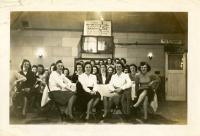Fancy a sandwich?
A common message to the Canadian civilian population during the Second World War was that their responsible food consumption was as important to the war effort as any other wartime activity. While soldiers fought overseas, Canadians at home could do their part in securing victory by adhering to coupon rationing, and abiding by the restrictions imposed by the Wartime Prices and Trade Board. In a message to the women of Canada, Donald Gordon, the Chairman of the Wartime Prices and Trade Board (WPTB) emphasized the important role of homemakers in ensuring that Canadians were kept strong and well-fed, while respecting the restrictions on food items such as meat, sugar, butter, tea, and coffee.
In a similar fashion, cafeterias and restaurants were subjected to regulations in the name of the war effort. For example, by following meatless Tuesdays as imposed by the WPTB, food establishments set an example to their communities of following food restrictions while still catering to patrons with delicious meals. Cafeterias, such as the one in the photograph, were forced to modify their menus in order to comply with rationing. After 1942, meatless days became more common, and between 1945 and 1947 there were up to two days (Tuesdays and Fridays) with no meat on the menu. If one looks closely at the sign behind the ladies in the picture, one would be able to see that the cafeteria was forced to reduced their number of sandwich offerings to only serve beef, pork, chopped egg, plain ham, and chicken. This would have likely change further as food rationing tightened in the later years of the war.
Photograph of a cafeteria, unknown location (c. 1942).

